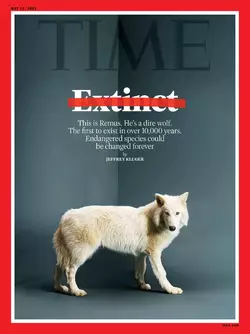
Nature gave the world the dire wolf 2.6 million years ago, and then, through the hard hand of extinction, took it away—some 10,000 to 13,000 years ago when the last of the species died out. Now, the dire wolf is back, brought bounding into the 21st century by Colossal Biosciences, a Dallas-based biotech company. On April 8, Colossal announced it had used both cloning and gene-editing based on two ancient samples of dire wolf DNA to birth three pups, the six-month-old males Romulus and Remus and the two-month-old female Khaleesi.
“Our team took DNA from a 13,000 year old tooth and a 72,000 year old skull and made healthy dire wolf puppies,” said Colossal CEO Ben Lamm in a statement that accompanied the announcement of the births. “It was once said, ‘any sufficiently advanced technology is indistinguishable from magic.’ Today, our team gets to unveil some of the magic they are working on.
So what, exactly, does that work involve?
Traditional cloning—the kind that famously resulted in Dolly the sheep in 1996, and has since been used to create clones of pigs, cats, deer, horses, mice, goats, gray wolves, dogs and more—is a relatively straightforward, if invasive, process. First, a single cell is taken from a tissue sample of the animal to be cloned. That cell’s nucleus—which contains the individual’s entire genetic code—is then extracted and inserted into a donor ovum from the same species whose own nucleus has been removed. The ovum carrying the new genetic material is allowed to develop into an embryo and then transferred into the womb of a surrogate, which ultimately gives birth to an exact duplicate of the animal from which the donor cell was taken.
Colossal says its dire wolf work had key differences. Scientists first analyzed the genome of the dire wolves contained in the ancient tooth and skull. Comparing those genomes to that of the gray wolf—the dire wolf’s closest living relative—they identified 20 differences in 14 genes that account for the dire wolf’s distinguishing characteristics, including its greater size, white coat, wider head, larger teeth, more powerful shoulders, more-muscular legs, and characteristic vocalizations, especially howling and whining.
Next, they harvested endothelial progenitor cells (EPCs), which form the lining of bloodvessels, from the bloodstreams of living gray wolves—a less invasive procedure than taking a tissue sample—and edited the 14 genes in their nuclei to express those 20 dire wolf traits. This is trickier than it seems, since genes often have multiple effects, not all of them good. For example, as the company explains in its press release, the dire wolf has three genes that code for its light coat, but in gray wolves they can lead to deafness and blindness. The Colossal team thus engineered two other genes that shut down black and red pigmentation, leading to the dire wolf’s characteristic light color without causing any harm in the edited gray wolf genome.
Once this was finished, the edited nuclei were next extracted from the cells and inserted into denucleated gray wolf ova. The ova were left to grow into embryos and 45 were transferred into the wombs of two domestic hound mixes. One embryo in each surrogate mother took hold, and after 65 days of gestation, Rolulus and Remus were born. A few months later, the procedure was repeated with a third surrogate who ultimately gave birth to Khaleesi. All three births were conducted by scheduled cesarean section to minimize the chances of injury during delivery. No surrogate dogs had a miscarriage or stillbirth during the process.
Colossal plans to use similar techniques to bring back the Ice Age woolly mammoth in 2028, editing living cell nuclei from Asian elephants—the mammoth’s closest living kin—to express mammoth traits preserved in nearly 60 sets of Ice Age remains. In early March, the company announced that it had successfully tested its methods in laboratory mice, producing 38 woolly mouse pups which bear the mammoth’s signature shaggy coat. Now it says it’s on track to have a surrogate elephant pregnancy in 2026 (elephants take nearly two years to gestate).
Other work in Colossal’s labs involves not bringing back extinct animals but attempting to save endangered ones. Endangered species can suffer from several issues, including a lack of genetic diversity—known as a “genetic bottleneck.” The relatively few animals left repeatedly mate with one another, and the inbreeding results in birth defects, sterility, and health problems proliferating through the species. Colossal has targeted some species with these problems, and is working to genetically edit more diversity into their populations.
One such project involves the all-but vanished pink pigeon. The pink pigeon species is indigenous to the island nation of Mauritius and once thrived there, until it lost its habitat as more and more of the island was given over to sugar plantations. Humanity’s introduction of rats and cats—which attack pigeon nests—drove the bird’s numbers down to just ten individuals. With the help of captive breeding programs, more than 650 pigeons were hatched and raised and released back on Mauritius. But with so few birds from which the captive population was bred, the species is experiencing high levels of infertility because of the genetic bottleneck.
To get around that, the scientists first tap into the fertilized egg of a pink pigeon and extract what are known as primordial germ cells (PGCs)—the cells that eventually become sperm and egg. In the lab, scientists then genetically edit the PGC genome to introduce greater genetic diversity—though at the moment Colossal is still studying the pink pigeon alleles and doesn’t yet know what traits that more-diverse coding will produce. Then, using the fertilized egg of a common chicken—which is far more plentiful than a pink pigeon egg—they inject the PGCs into the embryo. Once there, the cells travel to the gonads and create an embryo that, after it hatches, grows, and reaches sexual maturity, will produce not chicken chicks, but pigeon chicks. Eventually, those pigeons would be released into the wild population, producing genetically diverse young and helping to fortify the species.
None of this is easy and none of it comes cheap—though with a valuation of $10.2 billion, Colossal has the resources to pursue the science without too much concern about the price. And the company is not going it alone. It is partnering with conservation organizations such the American Wolf Foundation, The Mauritian Wildlife Foundation, Save the Elephants, and Conservation Nation. The company worked with the indigenous MHA Nation tribes (Mandan, Hidatsa, and Arikara) on the dire wolf project, and the tribes have expressed a desire to have dire wolves live on their lands in North Dakota. Colossal also says it's in advanced negotiations with the government of North Carolina to use its conservation strategies to help strengthen the endangered red wolf population there.
The company also believes that the new EPC cloning technique will allow them to save blood samples of existing species in a biobank as a hedge against their ever becoming endangered in the future. Romulus, Remus, and Khaleesi, the most conspicuous of the animals to emerge from Colossal’s labs, will surely not be the last.
https://time.com/7275439/science-behind-dire-wolf-return/ (Archive)





